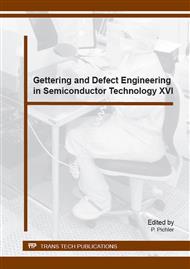[1]
H. Fischer and W. Pschunder. in Proceedings of the 10th IEEEPV. 1973. Palo Alto, USA.
Google Scholar
[2]
S. Rein and S.W. Glunz, Appl Phys Lett 82(7), (2003): pp.1054-56.
Google Scholar
[3]
K. Bothe and J. Schmidt, J Appl Phys 99(1), (2006): p.013701.
Google Scholar
[4]
V.V. Voronkov and R. Falster, J Appl Phys 107(053509), (2010): pp.1-8.
Google Scholar
[5]
A. Herguth, G. Schubert, et al. in Proceedings of the 4th WCPEC. 2006. Hawaii, USA.
Google Scholar
[6]
R. Kopecek, J. Arumughan, et al. in Proceedings of the 23rd EUPVSEC. 2008. Valencia.
Google Scholar
[7]
D. Macdonald, F. Rougieux, et al., J Appl Phys 105, (2009): p.093704.
Google Scholar
[8]
B. Lim, A. Liu, et al., Appl Phys Lett 95(23), (2009): p.232109.
Google Scholar
[9]
T. Schutz-Kuchly, J. Veirman, et al., Appl Phys Lett 96, (2010): p.
Google Scholar
[10]
V.V. Voronkov, R. Falster, et al., Solid State Phenomena 178-179, (2011): pp.139-146.
Google Scholar
[11]
V.V. Voronkov, R. Falster, et al., J Appl Phys 110(6), (2011): p.063515.
Google Scholar
[12]
B. Lim. Thesis, Leibnitz University Hannover. 2012, http: /d-nb. info/1021189596.
Google Scholar
[13]
M. Forster, E. Fourmond, et al., Appl Phys Lett 100(4), (2012): p.042110.
Google Scholar
[14]
J. Broisch, J. Haunschild, et al., IEEE J. Photovolt. 5(1), (2015): pp.269-275.
Google Scholar
[15]
J. Seiffe, L. Gautero, et al., J. Appl. Phys. 109(3), (2011): p.034105.
Google Scholar
[16]
J. Giesecke, M.C. Schubert, et al., Appl Phys Lett 97(9), (2010): p.092109.
Google Scholar
[17]
S. Wilking, M. Forster, et al., Sol Energ Mat Sol C (submitted), (2015): p.
Google Scholar
[18]
R.A. Sinton and A. Cuevas, Appl Phys Lett 69(17), (1996): pp.2510-2.
Google Scholar
[19]
F. Dannhäuser, Solid-State Electronics 15(12), (1972): pp.1371-5.
Google Scholar
[20]
J. Krausse, Solid-State Electronics 15(12), (1972): pp.1377-81.
Google Scholar
[21]
M. Forster, P. Wagner, et al., Sol Energ Mat Sol C 120, (2014): pp.390-395.
Google Scholar
[22]
F. Schindler, M. Forster, et al., Sol Energ Mat Sol C 131, (2014): pp.92-99.
Google Scholar
[23]
W. Shockley and W.T.J. Read, Physical Review 87(5), (1952): pp.835-42.
Google Scholar
[24]
R.N. Hall, Physical Review 87(2), (1952): p.387.
Google Scholar
[25]
J.D. Murphy, K. Bothe, et al., J Appl Phys 111(11), (2012): p.113709.
Google Scholar
[26]
T. Niewelt, J. Broisch, et al., Energy Procedia (accepted), (2015): p.
Google Scholar
[27]
A. Herguth and G. Hahn, J Appl Phys 108(11), (2010): p.
Google Scholar
[28]
S. Wilking, C. Beckh, et al., Sol Energ Mat Sol C 131(0), (2014): pp.2-8.
Google Scholar
[29]
C. Sun, F.E. Rougieux, et al., J Appl Phys 117(4), (2015): p.045702.
Google Scholar


